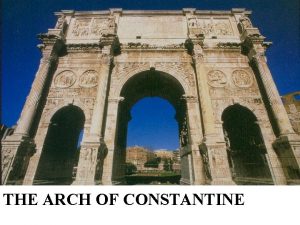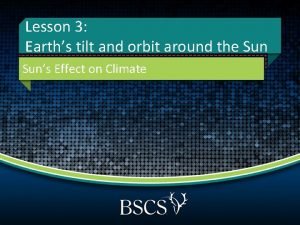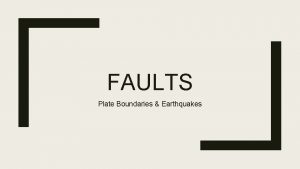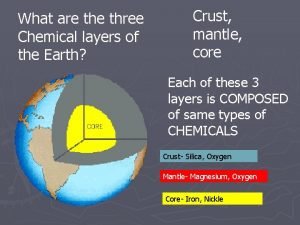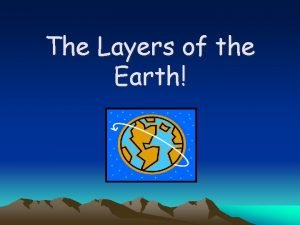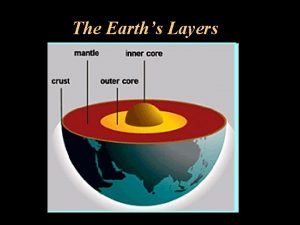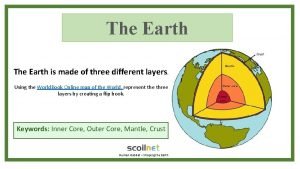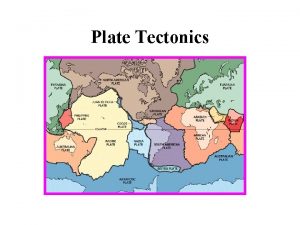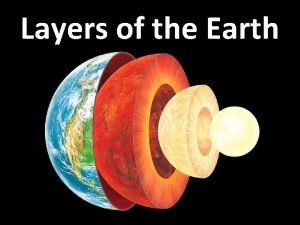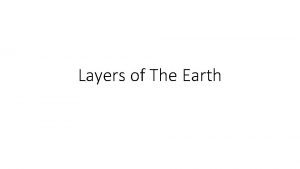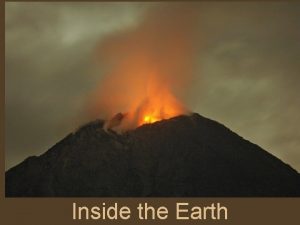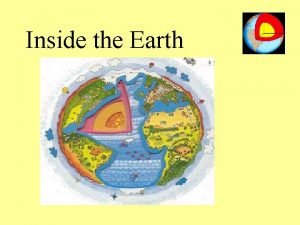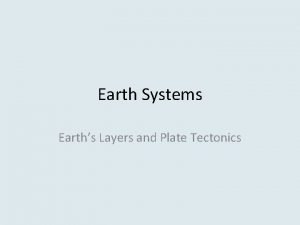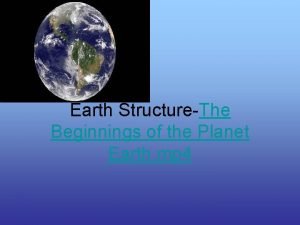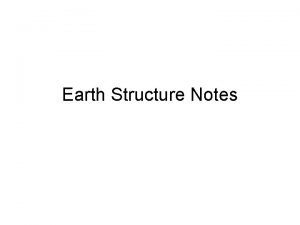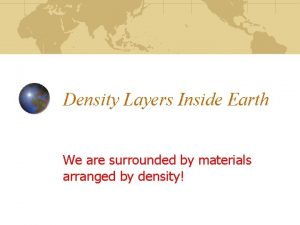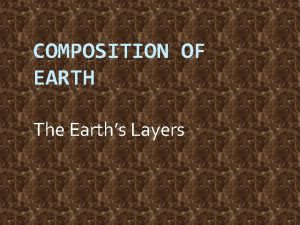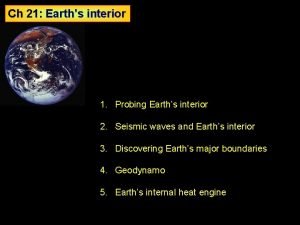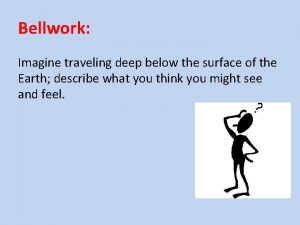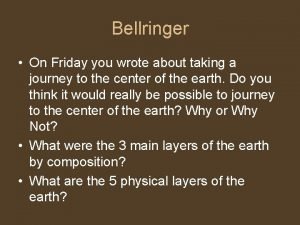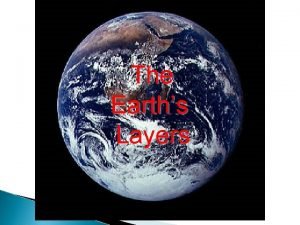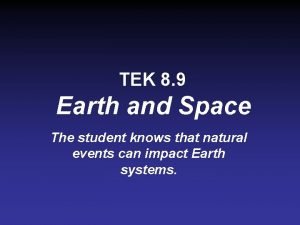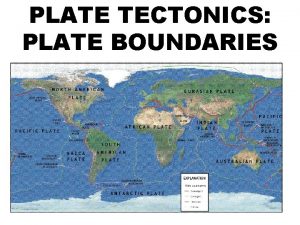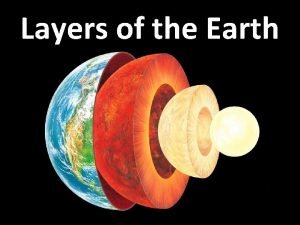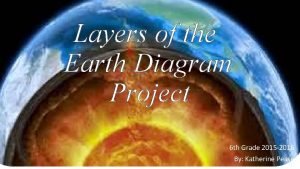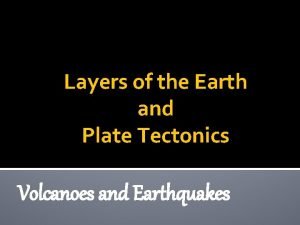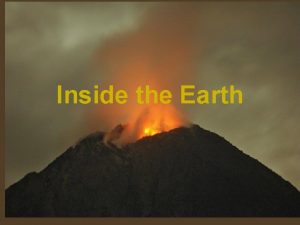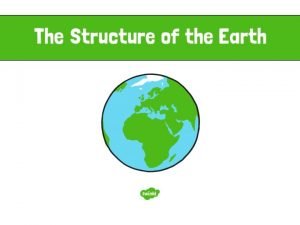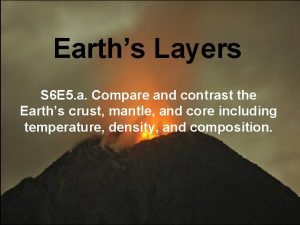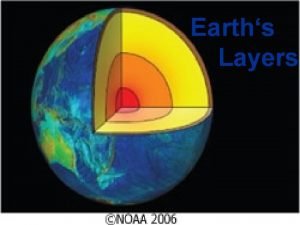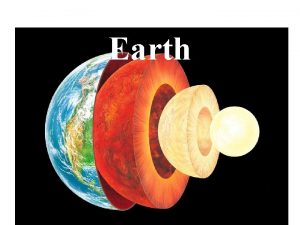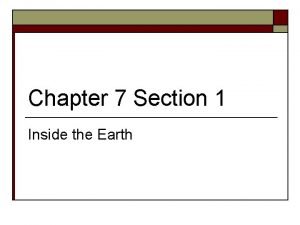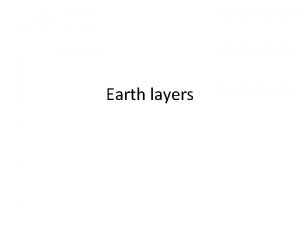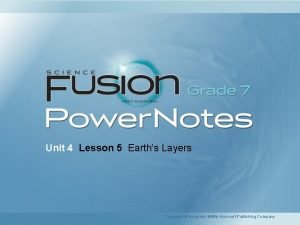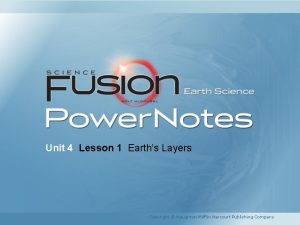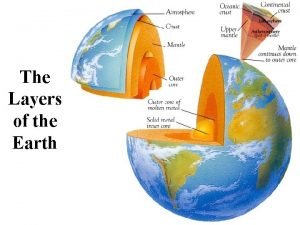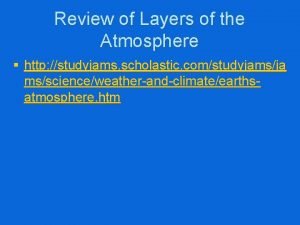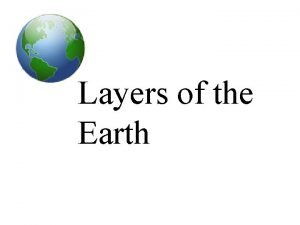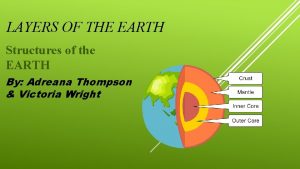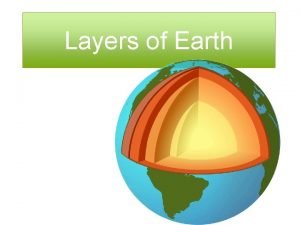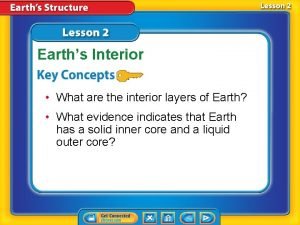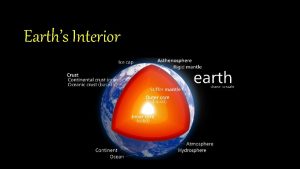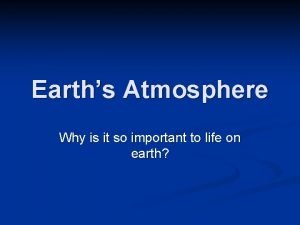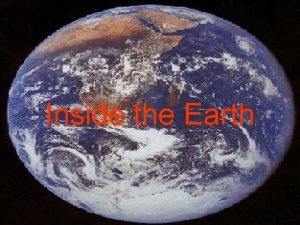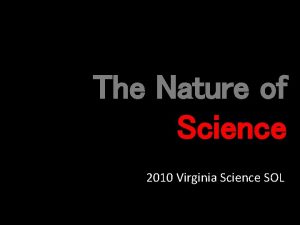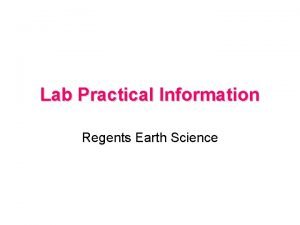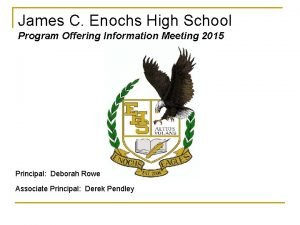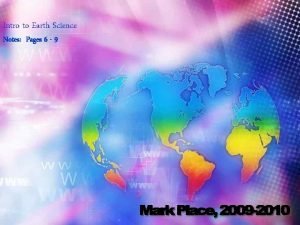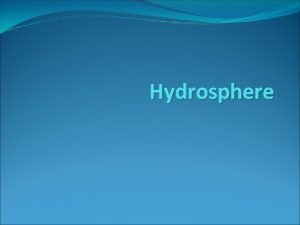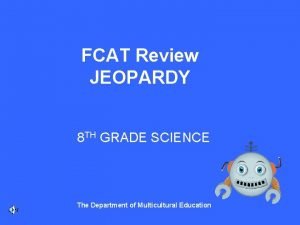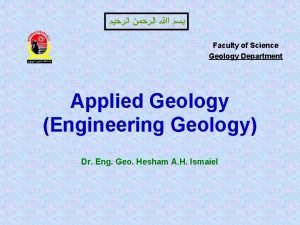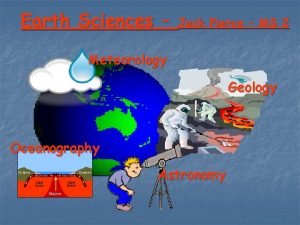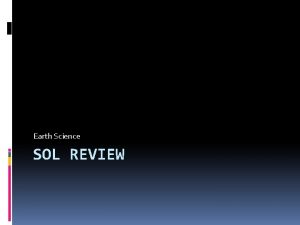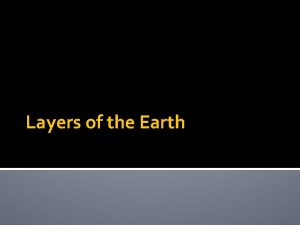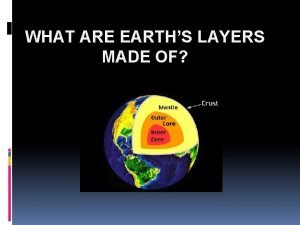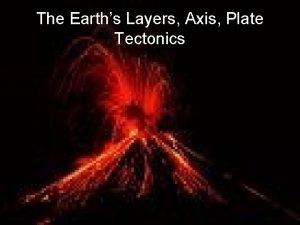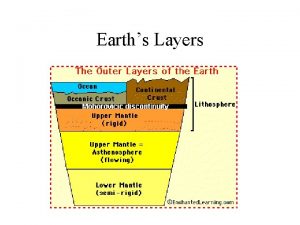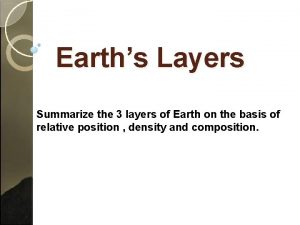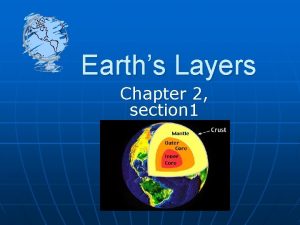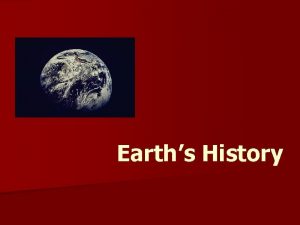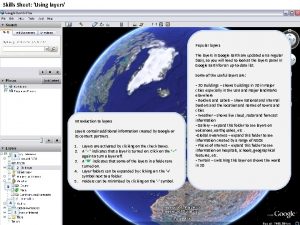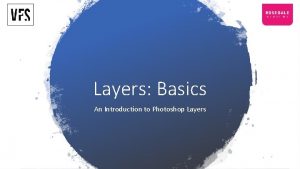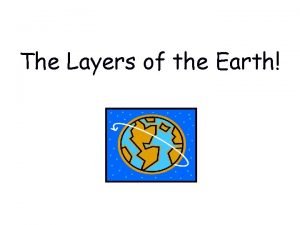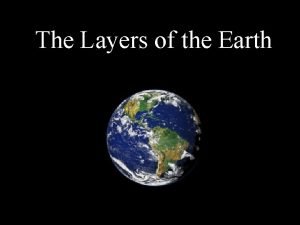Earth Science Layers of the Earth The Earths






























































































- Slides: 94

Earth Science Layers of the Earth

The Earth’s Layers



Lithosphere • The top part of the layer is the Earth’s crust. • The outermost layer of the earth known as the “rock sphere” that we live on. • It is divided into pieces called tectonic plates

Asthenosphere • The soft layer of the mantle below the lithoshphere. • Tectonic plates move above this layer.

Outer Core • The liquid layer below the earth’s mantle. • This layer surrounds the inner core.

Inner Core • The solid, dense center of our planet. • It is about 6, 374 km. beneath the earth’s surface.

“Plate tectonics” Theory: u explains motion/behavior of Earth’s lithosphere u. Moves a few centimeters a year u explains volcanoes, mountain building and earthquakes ustiff lithosphere floats on top of weak asthenosphere

Plate tectonics u about a dozen or so plates

Supporting evidence Modern measurements

EARTH is a Heat Engine What drives the plate movement?


Tectonic Plates • The place where two tectonic plates meet is called a plate boundary.

Plate Boundaries 3 types l divergent boundaries l convergent boundaries l transform fault boundaries

• http: //www. wwnorton. com/college/geo/eart h 2/content/chapter_4/animations. asp

PLATE TECTONICS 2) Plate boundaries l Divergent boundaries Mostly mid-ocean ridges (seafloor spreading) Typical spreading rates ~ 5 cm/year As oceanic moves away from ridge, it cools, & becomes denser Also found where continents break apart Example: Red Sea and East African Rift

Mid Ocean Ridges http: //earthquake. usgs. gov/learning/animations/

Continents Break Apart – Rift Valley

PLATE TECTONICS 2) Plate boundaries l Divergent boundaries Also found where continents break apart Example: Red Sea http: //www. wwnorton. com/college/geo/an imations/sea_floor_spreading. htm

PLATE TECTONICS 2) Plate boundaries Red Sea (looking southeast)

PLATE TECTONICS 2) Plate boundaries l Divergent boundaries Continents breaking apart Example: East African Rift Red triangles show the active volcanoes and the Afar Triangle (shaded, center)


Divergent Plate Boundaries

PLATE TECTONICS 2) Plate boundaries

Convergent Plate boundaries l Convergent boundaries Subduction zones ocean-continent - Volcanoes Examples: Mount St. Helens ocean-ocean - Volcanic island arcs Examples: Marianas, Aleutians, Hawaii continent-continent - Mountain Building Examples: Himalayas, Alps, Appalachians

continental crust and continental crust • Mountain building

Oceanic and oceanic crust • DEEPEST Trenches and Island Arcs Oceanic crust

Continental Crust and Oceanic Crust • Trenches and explosive volcanoes volcano Oceanic crust Continental crust Molten rock SUBDUCTION ZONE

• Mountains • Volcanoes, trenches & earthquakes


PLATE TECTONICS 2) Plate boundaries l Transform fault boundaries Strike-slip faulting Plates slide past each other: no production/destruction of material

STRESS • Stress occurs at plate boundaries. Stress causes rock to change shape or deform (deformation) Types of Stress: Type of boundary – Compression convergent – Tension divergent – Shearing transform

Stress Causes Deformation Bends and Breaks Rock

If you bump your bike into a large rock two things can happen. The metal can either bend or snap.

Stress Cause - Compression Effect: Folding • Folding- When rock layers bend because of stress on the earth’s crust. The types of folding are:

Folding • Anticline- Arch shape folds in the earths’ crust. pushing • Syncline- Trough shaped fold in a rock. pushing

Monocline • Monocline – simplest - involves a slight bend on one side

Anticline

Anticline

Anticline

Folding • Syncline- Trough shaped fold in a rock.

Syncline

Syncline

Syncline

Syncline

Syncline

Monocline • Monocline – simplest - involves a slight bend on one side

Monocline

Monocline

Monocline

Monocline

Monocline

Tectonic Plates • The place where two tectonic plates meet is called a plate boundary. (When there is enough pressure that builds up on the rocks’ edges and earthquakes can occur). • Earthquake Facts

Earthquake Animation

Tectonic Forces • Faulting- Stress that causes rocks to break • Faults slide past each other. • The types of faulting are: - normal fault - reverse fault - strike-slip fault

Fault Type #1: Normal Fault Cause: Tension/ Divergent movement Normal Faults- Effect: The hanging wall moves down, relative to the footwall. Normal because of the pull of gravity.

Normal Fault

Normal. Fault

Normal Fault

Fault Type #2: Reverse Fault Cause: Compression/ Convergent Movement Reverse Fault- Effect: The hanging wall moves up relative to the footwall.

Reverse Fault

Reverse Fault

Reverse Fault

Reverse Fault

Strike-Slip Fault Cause: shearing/ crosswise movement Strike-slip Faults- Effect: When opposing forces cause rock to break and move horizontally.

Strike Slip Fault

Strike Slip Fault

Strike Slip Fault San Andreas Fault


• US Geological Survey scientist Chris Mountain Building Newhall attaches a tape measure to a cliff Cause: Compression on Bubuin Island. Activity from nearby Effect: – crust is raised to higher Volcano. Uplift Island has lifted Bubuin by 15 centimeters elevation

Grand Canyon

Folded Mountains • In a folded mountain range, the rock layers are folded up.

Folded Mountains • Fault-Block • Folded • Volcanic

Folded Mountains Sierra Nevada

Folded Mountains Appalachian

Folded Mountains Appalachian Mountains

Fault-Block. Mountains • Fault-Block

Fault- Block Mountians • Rock layers are tilted up and can have sharp jagged peaks.

Fault-Block Mountains Grand Tetons from Jackson Lake Lodge (WY) are examples of fault block mountains.

Fault Block Mountain

Fault-Block Mountains • Big Bend Texas

Volcanic Mountains • Volcanic mountains are often cone shaped, and form along convergent boundaries. • Also forms along the divergent sea floor spreading

Volcanic Mountains

Volcanic Mountains • Mt. Ranier, Washington

Volcanic Mountains Mt. St. Helens, Washington

Volcanic Mountains Mt. Shasta, California

Volcanic Mountains • Volcanic mountains of Guatemala make up part of the Pacific's "Ring of Fire".

Popocatepetl, Mexico. December 12, 2007 this volcano spewed lava and ash two miles high.

Volcanic Mountains • Mt. St. Helens- Live

• On May 18, 1980, Mount St. Helens violently erupted. For 2 months the volcano showed signs that it was waking up from its 123 -year sleep. • Earthquakes beneath the mountain increased. Steam and ash erupted. • And a "bulge" grew on the mountain's steep north side. All these warning signs signaled that magma was moving upward inside the volcano.


US Volcanoes • Cascade Range Volcanoes • Major West Coast Volcanoes • Hawaii Volcano Map

 The earths layer foldable
The earths layer foldable The earths layer foldable
The earths layer foldable Earth's atmosphere description
Earth's atmosphere description Why science is your favourite subject
Why science is your favourite subject Earths roation
Earths roation Whats earths moon called
Whats earths moon called Earths biomes
Earths biomes Most abundant element in earth's crust
Most abundant element in earth's crust Basalt
Basalt Whats earths moon called
Whats earths moon called Thickest layer of the earth
Thickest layer of the earth Earths early atmosphere contained
Earths early atmosphere contained Earths major crustal plates
Earths major crustal plates Earths orbit seasons
Earths orbit seasons Brown earth soil profile
Brown earth soil profile Earths physical features
Earths physical features Earth's honey
Earth's honey Whats the name of earths moon
Whats the name of earths moon Earths mantle
Earths mantle Earths crust
Earths crust Where
Where Spring earth tilt
Spring earth tilt What is the true shape of earth
What is the true shape of earth Arch of constantine frieze
Arch of constantine frieze What does earths tilt do
What does earths tilt do Earths boundaries
Earths boundaries 4 spheres of the earth
4 spheres of the earth Earth composition
Earth composition Earth layers vocabulary
Earth layers vocabulary How many layers are there in the earth
How many layers are there in the earth What is the thickest layer of the earth?
What is the thickest layer of the earth? Earth different layers
Earth different layers Egg tectonic plates
Egg tectonic plates Part of the earth
Part of the earth Layers of the earth
Layers of the earth A dense ball of solid metal.
A dense ball of solid metal. What is inside of earth
What is inside of earth Layers of earth from most dense to least dense
Layers of earth from most dense to least dense Earth layers activity
Earth layers activity How many layers of the earth
How many layers of the earth Earth's layers most dense to least dense
Earth's layers most dense to least dense Lithosphere ppt
Lithosphere ppt The earth's layers foldable
The earth's layers foldable Four layers of the earth
Four layers of the earth The boundary between the mantle and core
The boundary between the mantle and core Which layer is the least dense
Which layer is the least dense Earth layers lithosphere asthenosphere mesosphere
Earth layers lithosphere asthenosphere mesosphere Structural layers of earth
Structural layers of earth Earth's foldable layers
Earth's foldable layers What layers of earth make up the lithosphere
What layers of earth make up the lithosphere Earth's layers questions
Earth's layers questions Layers of the earth diagram
Layers of the earth diagram Oreo cookies plate tectonics
Oreo cookies plate tectonics Whats the composition of the mantle
Whats the composition of the mantle What are earth's physical layers
What are earth's physical layers Pic of layers of the earth
Pic of layers of the earth Lithosphere
Lithosphere What are earth's layers
What are earth's layers Layers of the earth
Layers of the earth Plate tectonics jeopardy
Plate tectonics jeopardy Chapter 7 section 1 inside the earth answer key
Chapter 7 section 1 inside the earth answer key Earth's layers
Earth's layers Rocky crust
Rocky crust Lithosphere
Lithosphere Earth's layers
Earth's layers Earth's layers
Earth's layers Layers of the earth
Layers of the earth Outer core
Outer core Studyjams atmosphere
Studyjams atmosphere Layers of the earth
Layers of the earth Layers of earth
Layers of earth Physical properties of core
Physical properties of core Earth air layers
Earth air layers Plasticity in earth's layers
Plasticity in earth's layers Earth's layers
Earth's layers Layers of earth crust
Layers of earth crust Atmosphere levels
Atmosphere levels Crust and mantle rap
Crust and mantle rap Geologic layers of earth
Geologic layers of earth Where do polar and tropical air masses develop
Where do polar and tropical air masses develop Earth science sol 2010
Earth science sol 2010 Nys earth science lab practical
Nys earth science lab practical Earth science regents part d
Earth science regents part d Earth science regents lab practical
Earth science regents lab practical Earth science grade 9
Earth science grade 9 Dynamic equilibrium earth science
Dynamic equilibrium earth science Hydrosphere includes all the
Hydrosphere includes all the Science jeopardy 8th grade
Science jeopardy 8th grade Geology earth science definition
Geology earth science definition Enviromental science final exam
Enviromental science final exam Earth science meaning
Earth science meaning Astronomy definition earth science
Astronomy definition earth science Earth science sol review
Earth science sol review Zone of aeration
Zone of aeration Earth science sol review
Earth science sol review























